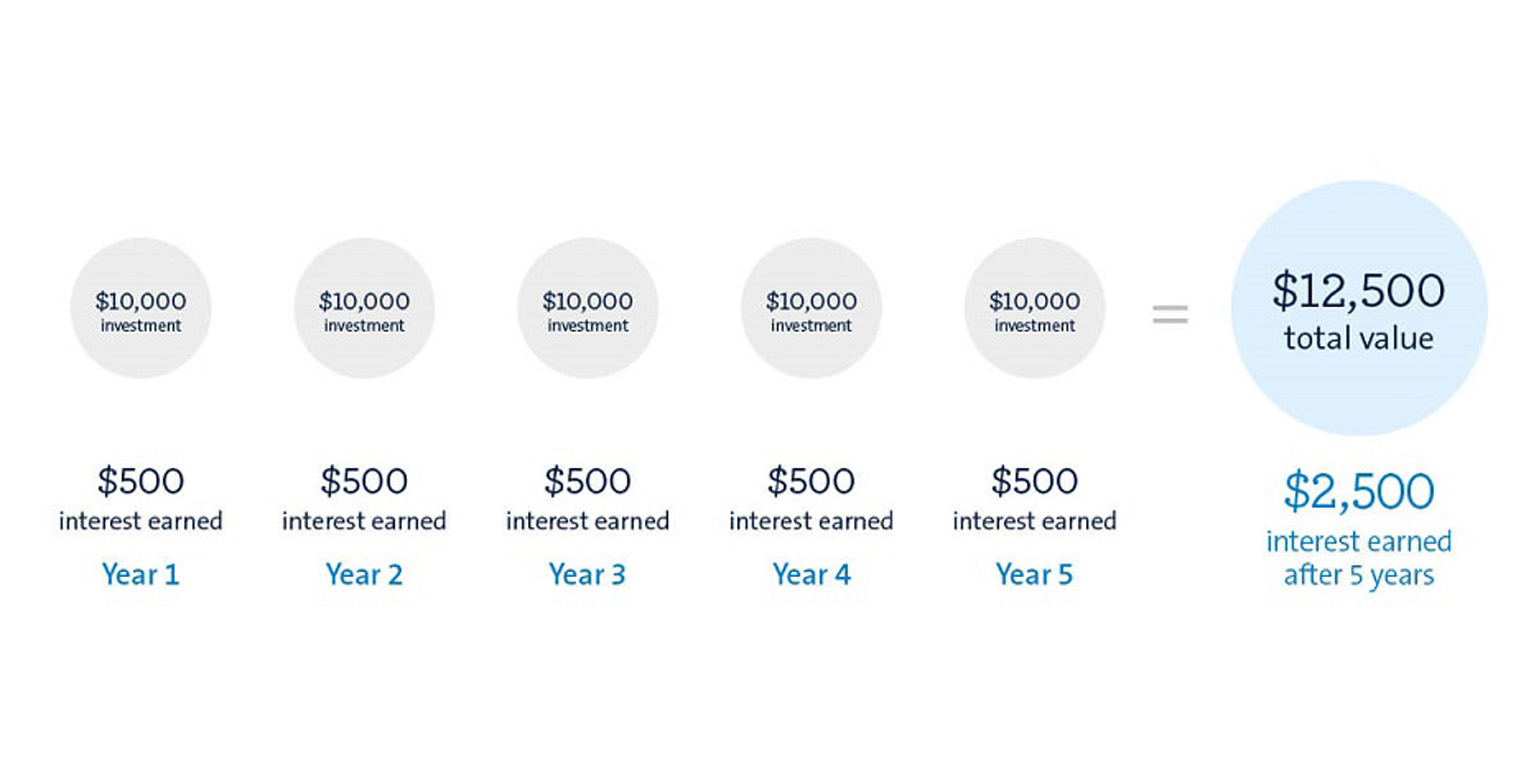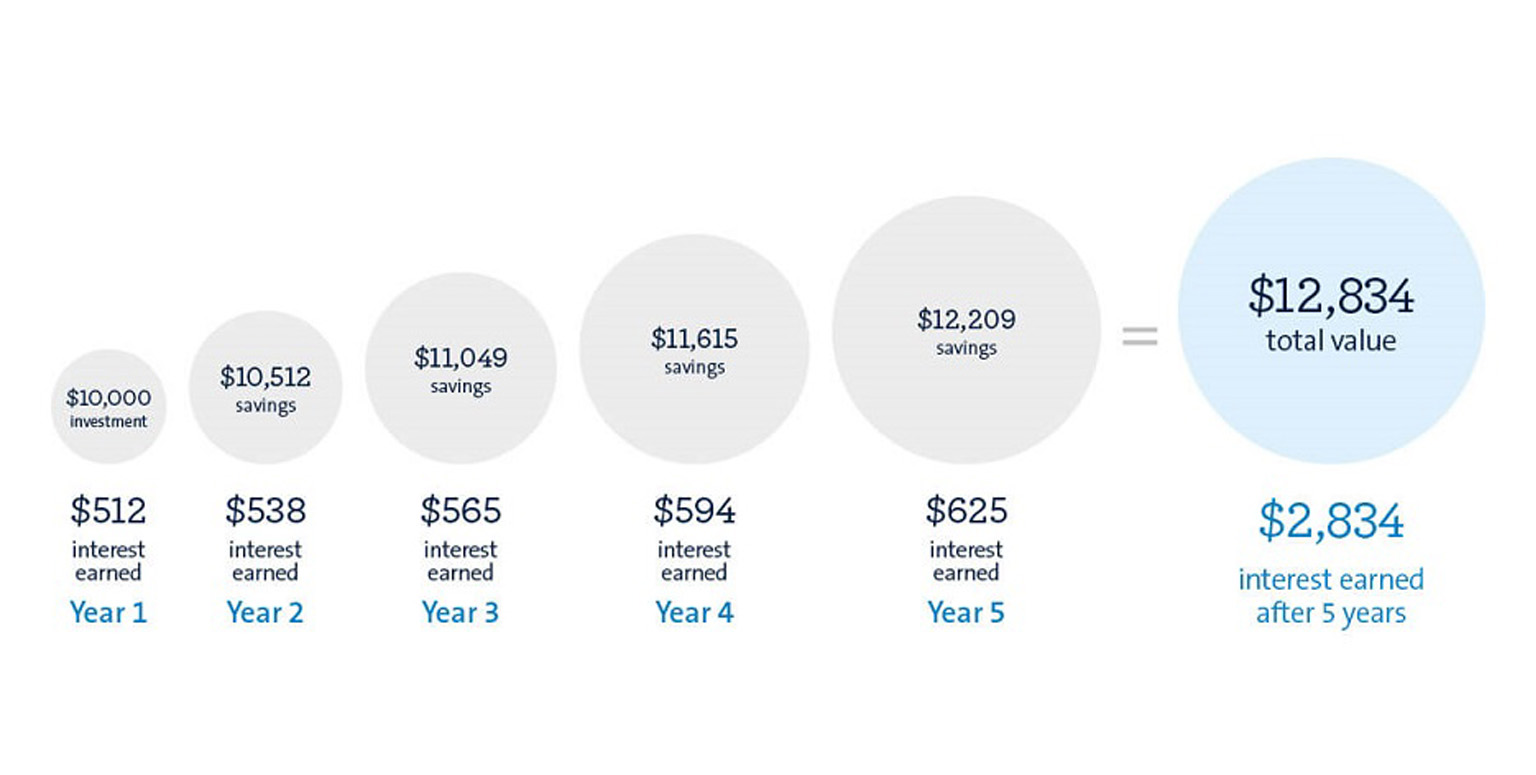If your goal is to save for the future, or perhaps start putting away for your children’s education - then unless you plan on putting your savings under your mattress, the sooner you start the better.
That’s because you could be missing out on earning compound interest along the way that could make a stark difference to the overall amount you save.
The difference between simple interest and compound interest
Simple interest is where a one-off interest payment is made at the end of an agreed, set period of time.
For example: if you invest $10,000 in a term deposit at 5% interest per annum, and don’t withdraw any money, then you’ll have $12,500 at the end of 5 years. That’s because the 5% annual interest rate is worked out based on the value of the initial investment and paid in full at the end.
Simple interest earnings over five years

Compound interest is where interest is paid in regular intervals, building on top of earlier interest paid. The result is a snowball effect of interest earning interest.
For example, (using the same figures as the simple interest example above), an initial investment of $10,000, earning 5% interest per annum with compound interest paid monthly, will give you $12,834 after five years. That’s because every month the interest earned was earning more interest.
Compound interest earnings over five years

Compound interest will continue to build on itself in this way, assuming nothing changes. How quickly it grows will depend on when you start your savings plan, what the interest rate is, and whether you make contributions (or withdrawals).
It can help your savings grow faster than simple interest. It's when interest earned on savings is reinvested, building on top of earlier interest received. The result may lead to a snowball effect of interest earning interest.
How to work out compound interest
The easiest way to work out how much compound interest you could earn on your savings, is to use an online compound interest calculator, that can do it for you.
Saving for the future
If you’re interested in using compound interest to help your savings grow, then the sooner you start, the better. That’s because, like any good snowball, the earlier it starts rolling, the more snow it will collect along the way.
For example, if you were keen to put aside money for your child’s education, and from the day your child was born, you put $10 per week into a bank account paying 6.25% pa, then by the time they turned 25, their savings would be $31,259. Of that, the interest earned would be $18,372 - outweighing the overall deposits made along the way.
If you started saving later, when your child turned 10, with a first deposit of $5,000, then by the time your child turned 25, they would have savings of $25,611. Of that, the interest earned would be about equal to the overall deposits made, and your savings would be about $6,000 less than if you’d started earlier, without an initial deposit.
This example uses the ASIC Money Smart Calculator1 featuring an effective interest rate of 6.43%. It’s important to remember that a model is not a prediction and uses assumptions. Results are only estimates, the actual amounts may be higher or lower.
Tax on compound interest
It’s worth remembering that like any income, compound interest earnings must be declared to the tax office, even if it’s savings for a child. Who declares the interest earned, depends on who owns or uses the funds of that account. You can find out more about the tax requirements from the Australian Tax Office.
You may also like
-

Weekly market update - 12-12-2025 Global shares were mixed over the last week with the Fed cutting rates but AI worries remaining. -

Oliver's insights - RBA holds rate with hawkish tones The RBA’s decision to leave rates on hold at 3.6% was no surprise with it being the consensus amongst all 29 economists surveyed by Bloomberg and the money market factoring in zero chance of a change. -

Oliver's Insights 2026 Predictions after 2025 success 2025 initially saw turmoil as US President Trump announced tariffs that were much higher than expected along with a bunch of other moves to upend US institutions and the global economic order. But the global economy held up okay.
Important information
Any advice and information is provided by AWM Services Pty Ltd ABN 15 139 353 496, AFSL No. 366121 (AWM Services) and is general in nature. It hasn’t taken your financial or personal circumstances into account. Taxation issues are complex. You should seek professional advice before deciding to act on any information in this article.
It’s important to consider your particular circumstances and read the relevant Product Disclosure Statement, Target Market Determination or Terms and Conditions, available from AMP at amp.com.au, or by calling 131 267, before deciding what’s right for you. The super coaching session is a super health check and is provided by AWM Services and is general advice only. It does not consider your personal circumstances.
You can read our Financial Services Guide online for information about our services, including the fees and other benefits that AMP companies and their representatives may receive in relation to products and services provided to you. You can also ask us for a hardcopy. All information on this website is subject to change without notice. AWM Services is part of the AMP group.
1 ASIC Money Smart Compound Interest Calculator - https://www.moneysmart.gov.au/tools-and-resources/calculators-and-apps/compound-interest-calculator








